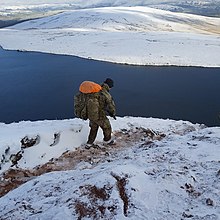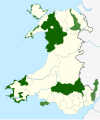Bannau Brycheiniog
Toponymy
The name Bannau Brycheiniog is first attested in the sixteenth century, and 'Brecon Beacons' first occurs in the eighteenth century as "Brecknock Beacons". Bannau Brycheiniog derives from the Welsh bannau, "peaks", and Brycheiniog, the name of an early medieval kingdom which covered the area. The English name is derived from the Welsh one; in the eleventh century the town of Brecon is recorded as 'Brecheniauc', which became "Brecknock" and "Brecon".
In a paragraph on Brecknockshire, John Leland's 1536–1539 Itinerary notes that:
Blak Montayne is most famose, for he strecchith, as I have lerned, his rootes on one side within a iiii. or v. myles of Monemuth, and on the other side as nere to Cairmerdin (Carmarthen). Though this be al one montayne, yet many partes of him have sundry names.
Leland ascribes the name "Banne Brekeniauc" to the hills surrounding "Artures Hille" (Pen y Fan), also calling the range the "Banne Hilles".
The term "Brecknock Beacons" was used in the eighteenth century and referred to the area around Pen y Fan, which was itself sometimes called 'the (Brecknock) Beacon'. For instance, Emanuel Bowen's A New and accurate map of South Wales (1729) labels the peak as 'The Vann or Brecknock Beacon', John Clark's 1794 General View of the Agriculture of the County of Brecknock refers to 'the Vann, or Brecknock Beacon, the undisputed sovereign of all the mountains in South Wales', and an 1839 tithe map of Cantref parish labels the mountain simply 'Beacon'. A slightly wider definition was used in 1809 by the Breconshire historian Theophilus Jones, who wrote that 'of the lofty summits of the Brecknock Beacons, that most southwards is the lowest, and the other two nearly of a height, they are sometimes called Cader Arthur or Arthur's chair'. This implies that "Brecknock Beacons" referred to only three summits, including Pen y Fan and Corn Du.
To distinguish the Brecons Beacons range from the national park, the range is sometimes called the "Central Beacons".
Geography

The Brecon Beacons comprises six main peaks, which from west to east are: Corn Du, 873 metres (2,864 ft); Pen y Fan, the highest peak, 886 metres (2,907 ft); Cribyn, 795 metres (2,608 ft); Fan y Bîg, 719 metres (2,359 ft); Bwlch y Ddwyallt, 754 metres (2,474 ft); and Waun Rydd, 769 metres (2,523 ft). These summits form a long ridge, and the sections joining the first four form a horseshoe shape around the head of the Taf Fechan, which flows away to the southeast. To the northeast of the ridge, interspersed with long parallel spurs, are four cirques (Welsh: cymoedd, sing. cwm) or round-headed valleys; from west to east these are Cwm Sere, Cwm Cynwyn, Cwm Oergwm and Cwm Cwareli.
The Brecon Beacons range, Fforest Fawr, and Black Mountain form a continuous massif of high ground above 300 metres (1000 feet). The A470 road forms an approximate boundary between the central Beacons and Fforest Fawr.
National park
The Brecon Beacons National Park was established in 1957, the third of the three Welsh parks after Snowdonia in 1951 and the Pembrokeshire Coast National Park in 1952. It covers an area of 519 square miles (1,340 km), which is much larger than the Brecon Beacons range. Over half of the park is in the south of Powys; the remainder of the park is split between northwestern Monmouthshire, eastern Carmarthenshire, northern Rhondda Cynon Taf and Merthyr Tydfil, and very small areas of Blaenau Gwent, and Torfaen.
Brecon Mountain Railway
A railway with narrow gauge trains is run by the Brecon Mountain Railway. The railway is a 1 ft 11+3⁄4 in (603 mm) narrow gauge tourist railway on the south side of the Brecon Beacons range. It climbs northwards from Pant along the full length of the Pontsticill Reservoir (also called 'Taf Fechan' reservoir by Welsh Water) and continues past the adjoining Pentwyn Reservoir to Torpantau railway station. The railway's starting point at Pant is located two miles (3 km) north of Merthyr Tydfil town centre.
Military training

The Brecon Beacons are used for training members of the UK armed forces and military reservists. The Army’s Infantry Battle School is located at Brecon, and the Special Air Service (SAS) and Special Boat Service use the area to test the fitness of applicants. An exercise unique to the area is the 'Fan dance', which takes place on Pen y Fan. In July 2013 three soldiers died from overheating or heatstroke on an SAS selection exercise. An army captain had been found dead on Corn Du earlier in the year after training in freezing weather for the SAS.
See also
References
- ^ "How to pronounce Bannau Brycheiniog and Eryri". 17 April 2023.
- ^ "Hills and mountains". Brecon Beacons National Park, Wales. Retrieved 19 November 2023.
- ^ "A Guide to Climbing Corn DU and Pen y Fan Mountains - ViewBritain.com". 17 April 2021. Retrieved 19 November 2023.
- ^ Ltd, Copyright The mountain Guide-A.-Connect. "Craig Gwaun Taf (Duwynt) | Wales". UK mountain Guide. Retrieved 19 November 2023.
- ^ Owen, Hywel Wyn; Morgan, Richard (2007). Dictionary of the Place-Names of Wales. Llandysul: Gomer. p. 45. ISBN 978-1-84323-901-7. OCLC 191731809.
- ^ Owen, Hywel Wyn; Morgan, Richard (2007). Dictionary of the Place-Names of Wales. Llandysul: Gomer. p. 45. ISBN 978-1-84323-901-7. OCLC 191731809.
- ^ Mills, A. D. (1 January 2011), "Brecon", A Dictionary of British Place Names, Oxford University Press, doi:10.1093/acref/9780199609086.001.0001, ISBN 978-0-19-960908-6, retrieved 9 June 2023
- ^ Smith, Lucy Toulmin, ed. (1906). The Itinerary in Wales of John Leland in or about the years 1536–9. London: George Bell and Sons. pp. 104, 106, 110.
- ^ Bowen, Emanuel (1729). "A New and accurate map of South Wales containing the counties of Pembroke, Glamorgan, Carmarthen, Brecknock, Cardigan and Radnor wherein are exactly laid down and delineated from an actual survey and admeasurement all the towns, villages, churches, chaples, gentlemen's seats". National Library of Wales. Archived from the original on 15 June 2022. Retrieved 17 April 2023.
- ^ Clark, John (1794). General View of the Agriculture of the County of Brecknock. London. p. 9. Archived from the original on 18 April 2023. Retrieved 18 March 2023.
- ^ "Plan of the parish of Cantref in the County of Brecon". People's Collection Wales. Archived from the original on 16 February 2023. Retrieved 15 February 2023.
- ^ Jones, Theophilus (1809). A History of the County of Brecknock. Vol. II.I. Brecknock. p. 388. Archived from the original on 18 April 2023. Retrieved 17 April 2023.
- ^ "Central Beacons". European Atlantic Geoparks Route. 3 March 2020. Retrieved 23 June 2023.
- ^ "Five great places to walk in the Bannau Brycheiniog (Brecon Beacons) National Park". VisitWales. Retrieved 17 July 2023.
- ^ "A short history". Brecon Beacons National Park, Wales. Retrieved 19 November 2023.
- ^ "The Authority's History". Park Authority. Retrieved 19 November 2023.
- ^ "Coastal Features". Pembrokeshire Coast National Park. Retrieved 19 November 2023.
- ^ Farmer, Ben (14 July 2013). "Two soldiers die in heat while training in Brecon Beacons". The Telegraph. Archived from the original on 14 January 2015. Retrieved 14 January 2015.
- ^ Farmer, Ben (2 July 2014). "No SAS manslaughter charges over Brecon Beacons deaths". The Telegraph. Archived from the original on 14 January 2015. Retrieved 14 January 2015.
- ^ "SBS - Selection". www.eliteukforces.info. Retrieved 9 June 2023.
- ^ "BBC Radio 4 Extra - Gone to Earth, 1. The Fan Dance". BBC. Retrieved 9 June 2023.
External links
- Tourist Information Brecon Beacons Park, Official Brecon Beacons Tourism Association
